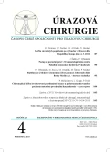LIVER TRAUMA MANAGEMENT IN TRAUMATOLOGICAL CENTRE FACULTY HOSPITAL KRÁLOVSKÉ VINOHRADY
Authors:
Jakub Štefka; František Vyhnánek
Authors‘ workplace:
Traumatological Centre, Faculty Hospital Královské Vinohrady, Department of Surgery, 3. Faculty of Medicine, Charles University, Prague
; Traumatologické centrum FNKV, Chirurgická klinika 3. LFUk a FNKV, Praha
Published in:
Úraz chir. 23., 2015, č.4
Overview
INTRODUCTION:
The liver is the second most frequently injured abdominal organ. In a blunt mechanism the most frequent causes include traffic accidents and falls. Penetrating injuries of the liver are often a result of a puncture or stabbing. An adequate diagnostic and therapeutic procedure in liver trauma is of great importance, because a complex liver injury in polytraumatized patient is associated with the development of posttraumatic reaction (hypothermia, acidosis, coagulopathy) and its consequences for the diagnostic and therapeutic algorithm. The beneficial diagnostic element is the examination by multidetector computed tomography (MDCT) to display the extent of the accident lesion with its classification and further indication of treatment. The treatment procedures have advanced to inclusion of non-surgical treatment and “damage control surgery * as well as angioembolization. Patients with injuries to the liver of grade III are usually treated conservatively. Extensive liver injury of grade IV to V is indicated for surgical revision to even a temporary stop of bleeding in a stage treatment through “damage control surgery”.
THE AFFECTED, METHOD AND RESULTS: Based on a retrospective analysis we evaluated the procedure in 42 injured hospitalized with injuries to liver in the traumatology center in 2012-2014. Blunt liver injury was diagnosed in 36 patient, of which 21 within polytrauma. In four patients, liver injury originated in diagnostic puncture and in two as a result of stab and gunshot. According to the extent of the injury of grade II and III prevailed (17 and 18 wounded). Non-surgical treatment was indicated in 20 patients and surgical revision in 22 of the injured. Individual interventions on the liver included parenchyma suture in 13 patients, in six of whom complemented with perihepatic packing. In addition to ligation of the injured larger vascular branch a tamponade was made in four injured with liver injury of grade III and IV. Another two patients with grade IV liver injury were treated by partial debridement of devitalized tissue with non-anatomical resection of torn parenchyma. Nephrectomy and splenectomy was performed for complex kidney and spleen injury in other two patients. From a total of 22 operated patients the “damage control surgery” was performed in 12 injured. In posttraumatic period within 30 days we have not observed death related to liver injury.
CONCLUSION:
The management of liver injury is determined by heterogenicity of anatomical configuration of liver injury, hemodynamic status and associated injuries within polytrauma. Although the importance of non-surgical treatment, and the number of the injured has been growing, the concept of “damage control surgery” is a method of choice for large hepatic injuries. Perihepatic tamponade has been widely accepted technique to stop bleeding. The improvement of the results in the treatment of liver injury is determined by multidisciplinary approach with inclusion of damage control resuscitation algorithm and post-operative and post-traumatic intensive care for severe lethal triad.
KEY WORDS:
Liver injury, diagnostics, treatment principles.
Sources
1. ASENSIO, JA., PETRONE, P., GARCIA-NUNEZ L. et al. Multidisciplinary approach for the management of complex hepatic injuries AAST-OIS grades IV-V: a prospective study. Scand J Surg. 2007, 96, 214–220. ISSN 14574969
2. DI SAVERIO, S., SIBILIO, A., CONIGLIO, C. et al. A proposed algorithm for multimodal liver trauma management from a surgical trauma audit in a western European trauma center. Minerva Anestesiol. 2014, 80, 1205–1216. ISSN 0375-9393
3. LEPPÄNIEMI, AK., MENTULA, PJ., STRENG MH. et al. Severe hepatic trauma: nonperative management, definitive repair, or damage control surgery? World J Surg. 2011, 35, 2643–2649. ISSN 0364-2313
4. LI, M., YU, WK., WANG, XB. et al. Non-operative management of isolated liver trauma. Hepatobiliary Pancreat Dis Int. 2014, 13, 545–550. ISSN 1499-3872
5. LI PETRI, S., GRUTTADAURIA, S., PAGANO, D. et al. Surgical management of complex liver trauma: a single liver transplant center expe-rience. Am Surg. 2012, 78, 20–25. ISSN 0002-9610
6. MORALES URIBE, CH., LÓPEZ, CA., COTE, JC. et al. Surgical treatment of blunt liver trauma, indications for surgery and results. Cir Esp. 2014, 92, 23–29. ISSN 0009-739X
7. PEITZMAN, AB., MARSH, JW. Advanced operative techniques in mana-gement of complex liver injury. J Trauma Acute Care Surg. 2012, 73, 765–770. ISSN 2163-0755
8. POLANCO, P., LEON, S., PINEDA, J. Hepatic resection in the management of complex injury to the liver. J Trauma. 2008, 65,1264–1269. ISSN 0022-5282
9. PRICHAYUDH, S., SIRINAWIN, C., SRIUSSADAPORN,S. et al. Management of liver injuries: predictors for the need of operation and da-mage control surgery. Injury. 2014, 45, 1373–1377. ISSN 00201383
10. SWIFT, C., GARNER, JP. Non-operative management of liver trauma. JR Army Med Corps. 2012, 158, 85–95. ISSN 0035-8665
11. VYHNÁNEK, F.: Současný postup u poranění jater. Úraz chir. 2012, 20, 36–42. ISSN 1211-7080
Labels
Surgery Traumatology Trauma surgeryArticle was published in
Trauma Surgery

2015 Issue 4
- Metamizole vs. Tramadol in Postoperative Analgesia
- Metamizole at a Glance and in Practice – Effective Non-Opioid Analgesic for All Ages
- The Importance of Hydration in Wound Healing
- Obstacle Called Vasospasm: Which Solution Is Most Effective in Microsurgery and How to Pharmacologically Assist It?
- Possibilities of Using Metamizole in the Treatment of Acute Primary Headaches
Most read in this issue
- Stabilisation of flail chest with rib plates Medin company- innovation of technics
- Surgical treatment of perilunate dislocation in multiple injured patient using proximal row carpectomy – case report
- LIVER TRAUMA MANAGEMENT IN TRAUMATOLOGICAL CENTRE FACULTY HOSPITAL KRÁLOVSKÉ VINOHRADY
- TREATMENT OF SEVERE BURNS AFTER THE EXPLOSION INCIDENT IN BRAZZAVILLE/REP. OF CONGO ON THE 4TH OF MARCH 2012
